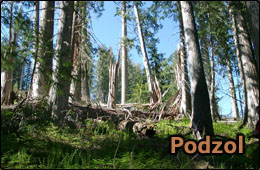Soil Site Details: UBC Cultivated Site
Soils on this site are classified as Podzols. Many would consider the Podzols to be the most visually striking soils in Canada. Podzols are one of the most common soils found under coniferous (evergreen) forests.
Basic Facts
Soil Order: Podzol
Ecosystem: Agriculture
Climate Zone: Humid Maritime
BC Biogeoclimatic Zone: Coastal Western Hemlock
Location: UBC Farm
City, Region, Country: Vancouver, British Columbia, Canada
Lat / Long: 49.25002/ -123.239
Soil Order: Podzol
Great Group: Humo-Ferric Podzol
Subgroup: Duric Humo-Ferric Podzol
Soil Series: Bose
Classification Code: DU.HFP
Soil Horizons Present: Ap, Bf1, Bf2, BC, C
Diagnostic Horizon 1: Bf
Diagnostic Horizon 2:
Diagnostic Horizon 3:
Diagnostic Horizon 4:
Land Form: Glacial till
Parent Material: Glacial till
Elevation (m): 71
Topography: Level
Affected by Glaciation: Yes
Climate Zone: Humid Maritime
Mean Annual Temperature (C): 10
Minimum Annual Temperature (C): 6.5
Maximum Annual Temperature (C): 13.7
Mean Annual Precipitation (mm): 1200
Current Land Use: Agricultural, cultivated field
Original Vegetation: Douglas fir, western hemlock, western red cedar
Current Vegetation: Annual agricultural crops
PDF with details: 1_2_Bose.pdf
Soil texture horizons: Sandy loam (Ap), loamy sand (Bf and BC), sand (C)
Soil structure horizons: Weak granular (Ap), single grain, structureless (Bf, BC and C)
Forest Humus Form: None, removed by cultivation
Presence of Charcoal: Yes, in Bf
Presence of Coatings: Yes, Fe/Al coatings on coarse fragments in Bf
Primary Soil Process: Podzolization
Secondary Soil Process:
Links
Resources home: Principles, Land use, awareness, etc.
Processes: Podzol
Classification: Podzol
Virtual soil monoliths: via the left-side expanding menu.
Media

Soil profile description by Art Bomke & Rachel Strivelli at the UBC Cultivated Site. Photo Source: Maja Krzic (UBC)
Featured Expert: Dr. Art Bomke
Video host: Ms. Rachel Strivelli